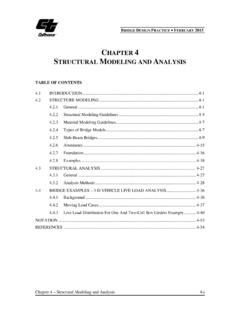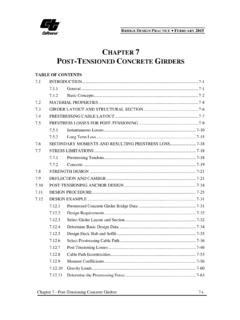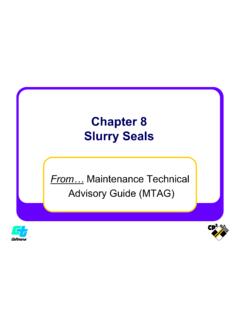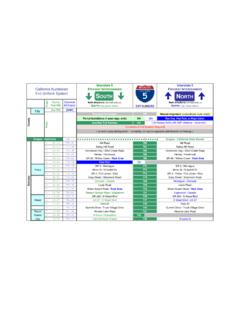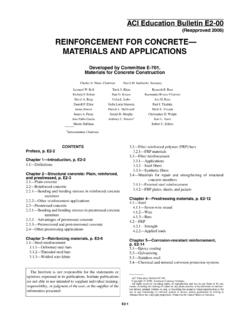Transcription of CHAPTER 850 PHYSICAL STANDARDS - Caltrans
1 Highway Design Manual 850-1 July 1, 2020 CHAPTER 850 PHYSICAL STANDARDS Topic 851 General Index Introduction This CHAPTER deals with the selection of drainage facility material type and sizes including pipes, pipe liners, pipe linings, drainage inlets and trench drains. Selection of Material and Type The choice of drainage facility material type and size is based on the following factors: (1) PHYSICAL and Structural Factors. Of the many PHYSICAL and structural considerations, some of the most important are: (a) Durability. (b) Headroom. (c) Earth Loads. (d) Bedding Conditions. (e) Conduit Rigidity. (f) Impact. (g) Leak Resistance. (2) Hydraulic Factors.
2 Hydraulic considerations involve: (a) Design Discharge. (b) Shape, slope and cross sectional area of channel. (c) Velocity of approach. (d) Outlet velocity. (e) Total available head. (f) Bedload. (g) Inlet and outlet conditions. (h) Slope. (i) Smoothness of conduit. (j) Length. Suggested values for Manning's Roughness coefficient (n) for design purposes are given in Table for each type of conduit. See Index for use of Manning's formula. 850-2 Highway Design Manual May 20, 2022 Table Manning "n" Value for Alternative Pipe Materials(1) Type of Recommended "n" Value Conduit Design Value Range Corrugated Metal Pipe (2) (Annular and Helical) (3) 2 " x " corrugation - 3" x 1" " - 5" x 1" " - 6" x 2" " - 9" x 2 " " - Concrete Pipe Pre-cast - Cast-in -place - Concrete Box - Plastic Pipe Smooth Interior - Corrugated Interior - Spiral Rib Metal Pipe " (W) x 1" (D) @ 11 " o/c - " (W) x " (D) @ 7 " o/c - " (W) x 1" (D)
3 @ 8 " o/c - Composite steel Spiral Rib Pipe - steel Pipe, Ungalvanized -- Cast Iron Pipe -- Clay Sewer Pipe -- Polymer Concrete Grated Line Drain - Notes: (1) Tabulated n-values apply to circular pipes flowing full except for the grated line drain. See Note 5. (2) For lined corrugated metal pipe, a composite roughness coefficient may be computed using the procedures outlined in the HDS No. 5, Hydraulic Design of Highway Culverts. (3) Lower n-values may be possible for helical pipe under specific flow conditions (refer to FHWA's publication Hydraulic Flow Resistance Factors for Corrugated Metal Conduits), but in general, it is recommended that the tabulated n-value be used for both annular and helical corrugated pipes.
4 (4) For culverts operating under inlet control, barrel roughness does not impact the headwater. For culverts operating under outlet control barrel roughness is a significant factor. See Index Culvert Flow. (5) Grated Line Drain details are shown in Standard Plan D98G-D98J and described under Index (6) Grated Line Drains. This type of inlet can be used as an alternative at the locations described under Index (5) Slotted Drains. The carrying capacity is less than 18-inch slotted (pipe) drains. Highway Design Manual 850-3 July 1, 2020 Topic 852 Pipe Materials Reinforced Concrete Pipe (RCP) (1) Durability. RCP is generally precast prior to delivery to the project site.
5 The durability of reinforced concrete pipe can be affected by abrasive flows or acids, chlorides and sulfate in the soil and water. See Index Abrasion, and Index protection of Concrete Pipe and Drainage Structures from Acids, Chlorides and Sulfates. The following measures increase the durability of reinforced concrete culverts: (a) Cover Over reinforcing steel . Additional cover over the reinforcing steel should be specified where abrasion is likely to be severe as to appreciably shorten the design service life of a concrete culvert. This extra cover is also warranted under exposure to corrosive environments, see Index protection of Concrete Pipe and Drainage Structures from Acids, Chlorides and Sulfates.
6 Extra cover over the reinforcing steel does not necessarily require extra wall thickness, as it may be possible to provide the additional cover and still obtain the specified D-load with standard wall thicknesses. (b) Increase cement content. (c) Reduce water content. (d) Invert paving/plating. (2) Indirect Design Strength Requirements. (a) Design STANDARDS . The D load strength of reinforced concrete pipe is determined by the load to produce a inch crack under the 3-edge bearing test called for in AASHTO Designations M 170, M 207M/M 207, and M 206M/M 206 for circular reinforced pipe, oval shaped reinforced pipe, and reinforced concrete pipe arches, respectively.
7 (b) Height of Fill. See Topic 856. (3) Shapes. Reinforced concrete culverts are available in circular and oval shapes. Reinforced Concrete Pipe Arch (RCPA) shapes have been discontinued by West Coast manufacturers. In general, the circular shaped is the most economical for the same cross-sectional area. Oval shapes are appropriate for areas with limited head or overfill or where these shapes are more appropriate for site conditions. A convenient reference of commercially available products and shapes is the AASHTO publication, A Guide to Standardized Highway Drainage Products . (4) Non-Reinforced Concrete Pipe Option. Non-reinforced concrete pipe may be substituted at the contractor s option for reinforced concrete pipe for all sizes 36 inches in diameter and smaller as long as it conforms to Section 65 of the Standard Specifications.
8 Non-Reinforced concrete pipe is not affected by chlorides or stray currents and may be used in lieu of RCP in these environments without coating or the need to provide extra cover over reinforcement. (5) Direct Design Method RCP. (Contact DES - Structures Design) Concrete Box and Arch Culverts (1) Box Culverts. Single and multiple span reinforced concrete box culverts are completely detailed in the Standard Plans. For cast-in-place construction, strength classifications are shown for 10 feet and 20 feet overfills. Precast reinforced concrete box culverts require a minimum of 1 foot of overfill and are not to exceed 12 feet in span length. Special details are necessary if precast boxes are proposed as extensions for existing box culverts.
9 Where 850-4 Highway Design Manual July 1, 2020 the use of precast box culverts is applicable, the project plans should include them as an alternative to cast-in-place construction. Because the standard measurement and payment clauses for precast RCB s differ from cast-in-place construction, precast units must be identified as an alternative and the special provision must be appropriately modified. The standard plan sheets for precast boxes show details which require them to be layed out with joints perpendicular to the centerline of the box. This is a consideration for the design engineer in situations which require stage construction and when the culvert is to be aligned on a high skew.
10 This situation will require either a longer culvert than otherwise may have been needed, or a special design allowing for skewed joints. Prior to selecting the latter option DES - Structures Design should be consulted. (2) Concrete Arch Culverts. Technical questions regarding concrete arch culverts should be directed to the Underground Structures Branch of DES - Structures Design. (3) Three-Sided Concrete Box Culverts Design details for cast-in-place (CIP) construction three-sided bottomless concrete box culverts in 2-foot span increments from 12 feet to < 20 feet, inclusive, with strength classifications shown for 10 feet and 20 feet overfills are available upon request from DES - Structures Design.
